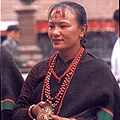Tangail saris made in the Burdhwan cluster of West Bengal originated in Tangail region of Bangladesh. During the partition, many weavers migrated from Tangail to Burdhwan and continued their craft.
Initially, silk weft were used with the combination of cotton warps. Gradually, cotton became more popularised and was used in both warp and weft. Cotton yarns of 80s and 100s count are generally used with higher reed count. Tussar silk yarn, mercerized cotton yarn and dyed twisted cotton yarn are used in borders of the saree for extra warp.
The body of the saree has repeated extra weft motifs and the pallu and border is sometimes weaved with zari and silver thread to give a subtle lustre. Both the body of the saree and pallu is weaved using jacquard loom. These sarees are also known as begum bahaar. These days, stoles, scarves, home furnishing materials are also created with this weaving.
Gallery
YOUR VIEWS
PRACTITIONERS: INDIA
Access 70,000+ practitioners in 2500+ crafts across India.
BIBLIOGRAPHY
10,000+ listings on arts, crafts, design, heritage, culture etc.
GLOSSARY
Rich and often unfamiliar vocabulary of crafts and textiles.
SHOP at India InCH
Needs to be written.






